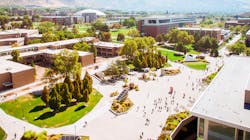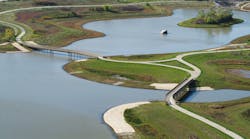The U.S. Environmental Protection Agency (EPA) has announced the winners of its tenth annual Campus RainWorks Challenge, a national competition that engages college students in the design of on-campus green infrastructure solutions to address stormwater pollution.
This year’s winning projects showcase the environmental, health, economic, and social benefits of green infrastructure.
“Green infrastructure is essential to building dynamic and thriving communities. When we apply green infrastructure strategies — like those exemplified by the Campus RainWorks winners — projects can meet community needs while supporting clean water goals,” said EPA Assistant Administrator for Water Radhika Fox. “The timing of this competition couldn’t be better, as we celebrate Water Week 2022, the 50th anniversary of the Clean Water Act, and begin to implement the Bipartisan Infrastructure Law. I would like to congratulate this year’s winners and I want to thank the faculty and thousands of students, past and present, that have endeavored to improve their community through Campus RainWorks.”
EPA’s Campus RainWorks Challenge invites students and faculty members at colleges and universities to apply green infrastructure design principles, foster interdisciplinary collaboration, and increase the use of green infrastructure on the nation’s college campuses.
This year, 42 teams from across 24 states and 35 different academic institutions competed in the Campus RainWorks Challenge’s two design categories. The Master Plan category examines how green infrastructure can be broadly integrated across campus, while the Demonstration Project category focuses on how green infrastructure can address stormwater pollution at a specific site on campus.
This year’s winners are:
Florida International University (1st Place Demonstration Project Category) – The team’s entry, titled “Resilient MAST@FIU” redesigned a local magnet high school campus to incorporate a variety of green infrastructure practices with the goal of improving water quality, reducing urban heat island effects, and mitigating the risk of coastal flooding due to climate change. The team engaged with local stakeholders and conducted sophisticated performance modeling to produce design solutions that would not only benefit the local campus and community but serve as a replicable example for other coastal educational institutions. Watch the team’s video about their design:EPA also recognized the University of Pennsylvania, the University of Maryland, the University of Illinois, and the University of Arkansas for honorable mention in the Demonstration Project category. Utah State University, the University of Portland, and Michigan State University were selected for honorable mention in the Master Plan category.
First place teams will receive a $7,000 student prize to be split among team members and a $3,000 faculty prize to support green infrastructure research and training. Second place teams will receive a $3,500 student prize and a $1,500 faculty prize.



